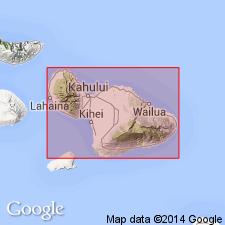
- Usage in publication:
-
- Hana volcanic series*
- Modifications:
-
- Named
- Dominant lithology:
-
- Basalt
- AAPG geologic province:
-
- Maui
Summary:
Named for exposures at type locality at village of Hana [20 deg 45' 49"N, 155 deg 59' 25"W, Hana 7.5' quad] east end of Island of Maui. Covers 3 distinct areas, east end, southwest end and summit depression. Includes Kipahulu member on western side of Kipahulu Valley [southeast side]. Includes tuff cone, Molokini Islet off southwestern coast. On northeastern side in Keanae Valley includes (oldest to youngest): Pauwalu, Wailuanui, Ohio, Piinaau, Waiokamilo, and Keanae basalts; in Nahiku area includes (oldest to youngest): Big Falls picritic basalts, Makapipi basalts, Waiaaka basaltic andesite, Kapaula basaltic andesite, Mossman picritic basalt, Paakea basalt, Hanawi basaltic andesite, and Kuhiwa basaltic andesite. Also includes historic flow of 1750(?). Composed of aa and few pahoehoe flows ranging from ultrabasic olivine augite porphyries to aphanitic andesites. Where flows filled valleys is as thick as 1000 ft. Overlies with erosional unconformity Kula volcanic series (new); in deep valley where Kula lavas were probably removed by erosion, Hana lavas lie on alluvium or on Honomanu basalts (new). Underlies Quaternary surficial deposits including Kaupo mudflow (new). Of Middle(?) and late Pleistocene and Recent age.
Source: GNU records (USGS DDS-6; Menlo GNULEX).
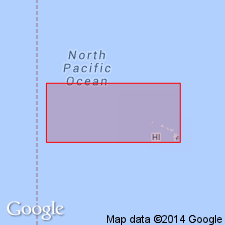
- Usage in publication:
-
- Hana volcanic series*
- Modifications:
-
- Age modified
- AAPG geologic province:
-
- Maui
Summary:
Includes [erroneously?] Kaupo mud flow in addition to units listed in Stearns and Macdonald (1942). Distinguished by structural relationships and in part petrographically from underlying Kula volcanic series. No fossils. Assigned Pleistocene and Recent age.
Source: GNU records (USGS DDS-6; Menlo GNULEX).
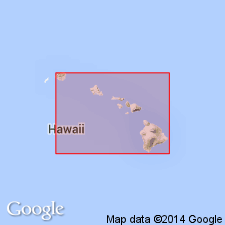
- Usage in publication:
-
- Hana volcanic series*
- Modifications:
-
- Age modified
- AAPG geologic province:
-
- Maui
Summary:
Is considered to be younger than 0.45 Ma, K-Ar age obtained from Hawaiite, (on south side of Island of Maui at Kalepa Point) from underlying Kula volcanic series.
Source: GNU records (USGS DDS-6; Menlo GNULEX).
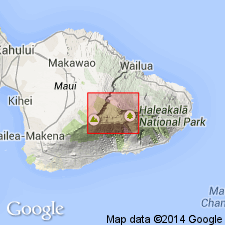
- Usage in publication:
-
- Hana Formation*
- Modifications:
-
- Revised
- AAPG geologic province:
-
- Maui
Summary:
Hana Volcanic Series by Stearns and Macdonald (1942) are here redesignated Hana Formation. [However status of formations included in Hana Volcanic Series outside of Haleakala Crater are not addressed.] Lava flows of Kalua Awa and Kaluu o ka Oa on west and east side of crater are youngest because they are overlain by no other units except windblown ash and their surfaces are very fresh with surface forms very well preserved. Picrite basalt in area northeast of Puu Kauaua [south side of crater] is probably oldest lava based on weathering and thickness of ash cover. Assigned Pleistocene and Holocene age.
Source: GNU records (USGS DDS-6; Menlo GNULEX).
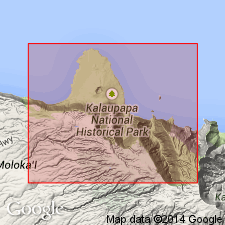
- Usage in publication:
-
- Hana Group*
- Modifications:
-
- Revised
- AAPG geologic province:
-
- Maui
Summary:
Hana Formation (Macdonald, 1978) here renamed Hana Group in accordance with art. 9(a) and 9(f) of Code of Stratigraphic Nomenclature.
Source: GNU records (USGS DDS-6; Menlo GNULEX).
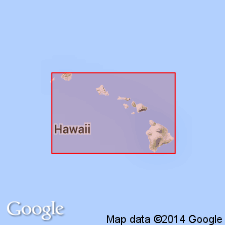
- Usage in publication:
-
- Hana Volcanics*
- Modifications:
-
- Revised
- AAPG geologic province:
-
- Maui
Summary:
Hana Volcanic Series (Stearns and Macdonald, 1942) and Hana Formation (Macdonald, 1978) reduced in rank "everywhere' and renamed Hana Volcanics to reflect varied lithology. Kipahulu is retained as member. Units in Keanae and Nahiki areas are abandoned as formally named units and are used as informally named flows. [see also names of units]. Considered Pleistocene(?) and Holocene age.
Source: GNU records (USGS DDS-6; Menlo GNULEX).
For more information, please contact Nancy Stamm, Geologic Names Committee Secretary.
Asterisk (*) indicates published by U.S. Geological Survey authors.
"No current usage" (†) implies that a name has been abandoned or has fallen into disuse. Former usage and, if known, replacement name given in parentheses ( ).
Slash (/) indicates name conflicts with nomenclatural guidelines (CSN, 1933; ACSN, 1961, 1970; NACSN, 1983, 2005, 2021). May be explained within brackets ([ ]).

